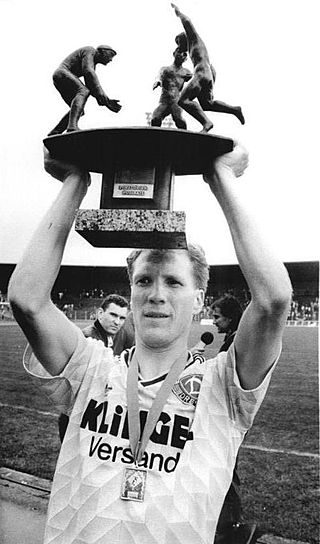
The FDGB-Pokal was an elimination football tournament held annually in East Germany. It was the second most important national title in East German football after the DDR-Oberliga championship. The founder of the competition was East Germany's major trade union.
The 1973–74 DDR-Oberliga was the 25th season of the DDR-Oberliga, the first tier of league football in East Germany.
The 1952–53 DDR-Oberliga was the fourth season of the DDR-Oberliga, the first tier of league football in East Germany.
The 1953–54 DDR-Oberliga was the fifth season of the DDR-Oberliga, the first tier of league football in East Germany.
The 1954–55 DDR-Oberliga was the sixth season of the DDR-Oberliga, the first tier of league football in East Germany. After the 1954–55 season the league played a transition round in autumn 1955, followed by five seasons, until 1960, where it played in the calendar year format. From 1961–62 onwards the league returned to its traditional format.
The 1956 DDR-Oberliga was the eighth season of the DDR-Oberliga, the first tier of league football in East Germany. Rather than in the traditional autumn-spring format the Oberliga played for six seasons from 1955 to 1960 in the calendar year format, modelled on the system used in the Soviet Union. From 1961–62 onwards the league returned to its traditional format.
The 1959 DDR-Oberliga was the eleventh season of the DDR-Oberliga, the first tier of league football in East Germany. Rather than in the traditional autumn-spring format the Oberliga played for six seasons from 1955 to 1960 in the calendar year format, modelled on the system used in the Soviet Union. From 1961–62 onwards the league returned to its traditional format.
The 1962–63 DDR-Oberliga was the 14th season of the DDR-Oberliga, the first tier of league football in East Germany.
The 1963–64 DDR-Oberliga was the 15th season of the DDR-Oberliga, the first tier of league football in East Germany.
The 1966–67 DDR-Oberliga was the 18th season of the DDR-Oberliga, the first tier of league football in East Germany.
The 1968–69 DDR-Oberliga was the 20th season of the DDR-Oberliga, the first tier of league football in East Germany.
The 1969–70 DDR-Oberliga was the 21st season of the DDR-Oberliga, the first tier of league football in East Germany.
The 1975–76 DDR-Oberliga was the 27th season of the DDR-Oberliga, the first tier of league football in East Germany.
The 1976–77 DDR-Oberliga was the 28th season of the DDR-Oberliga, the first tier of league football in East Germany.
The 1977–78 DDR-Oberliga was the 29th season of the DDR-Oberliga, the first tier of league football in East Germany.
The 1979–80 DDR-Oberliga was the 31st season of the DDR-Oberliga, the first tier of league football in East Germany.
The 1983–84 DDR-Oberliga was the 35th season of the DDR-Oberliga, the first tier of league football in East Germany.
The 1984–85 DDR-Oberliga was the 36th season of the DDR-Oberliga, the first tier of league football in East Germany.
The 1986–87 DDR-Oberliga was the 38th season of the DDR-Oberliga, the first tier of league football in East Germany.
The 1988–89 DDR-Oberliga was the 40th season of the DDR-Oberliga, the first tier of league football in East Germany.

